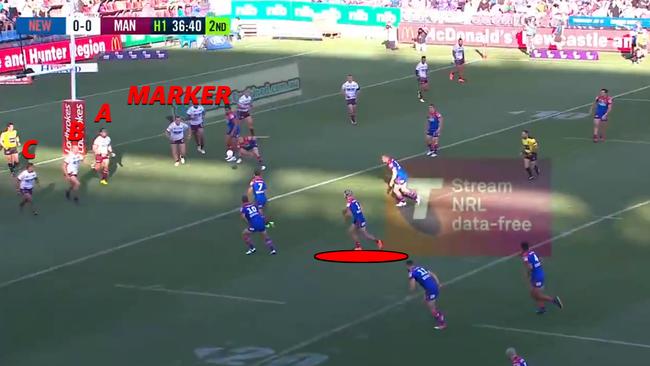Analysis: What makes Kalyn Ponga so potent in attack, and how can opposition defences combat him?
WE look at Kalyn Ponga’s greatest strength that separates him from the NRL’s “next big thing” of eras gone by, and a potential solution for opposition defences to combat his attacking potency.
Knights
Don't miss out on the headlines from Knights. Followed categories will be added to My News.
KALYN Ponga is the NRL’s most exciting prospect in generations, if not ever.
The hype isn’t overstated, the 20-year-old is a freakish talent.
His ability and maturity across the park is outstanding, but it’s what he does in the opposition 20m zone that separates him from the NRL’s “next big thing” tag of eras gone by.
So what is it exactly that makes him so potent attacking the tryline, and how can it be stopped?

Ponga has eight try-assists and one try in the opening seven rounds, all of which have come on the left side of the field.
This stat that gives opposition defensive coaches a glimmer of hope that Ponga can be limited in his effectiveness.
There is a method that may restrain his prowess, but firstly, here’s an in-depth breakdown of his ability to exploit a defensive line.
Be sure to watch each video for a greater understanding.

THE PLAY
Like every good playmaker, Ponga’s aim is to isolate a vulnerable defender.
He’ll look up off a quick play the ball, identify a back-rower (sometimes a half), and rely on his footwork to get on the player’s outside.
What this does is force the five-eighth or halfback defending three men in from the sideline to make a decision.
If the half thinks their back-rower on the inside is beaten they’ll jam on Ponga.
If the half hesitates or believes the back-rower is a chance at making the tackle they’ll hold their position to make the tackle on the lead runner (in Ponga’s case it’s generally Lachlan Fitzgibbon).
If the half jams on Ponga, it’s his outside centre’s job to then jam on the lead runner.
This is where Ponga excels.
His speed and footwork create three options, he just needs to choose the right one.
Making the correct choice in a split second is difficult for even the game’s elite playmakers, but Ponga tends to do so. It’s a true indicator of his match awareness and ability to read a play under pressure.
So what are the options?
OPTION A
The half holds his position, Ponga dummies and goes through the line himself to score the try.
OPTION B
The half jams on Ponga, the centre fails to jam with the half, allowing Ponga to pop a short-ball for Fitzgibbon to stroll through the gaping hole.
OPTION C
The best defensive units react in a cohesive manner to shut down a play.
If one player jams in to make a tackle, the men outside him must follow or risk leaving a hole in the defensive line.
Even this has failed to stop Ponga so far in 2018.
If the half jams on Ponga, the centre jams on Fitzgibbon, Ponga sees the space created out wide and fires a cut out ball to his unmarked winger.
This is by far the hardest option for Ponga, but one he’s got right more often than not so far in his young career.
POSSIBLE SOLUTION
It must be stressed, this is a POSSIBLE solution. There’s no foolproof answer, defensive units will be terrorised by the gifted fullback for years to come.
There is, however, an option that may limit his output.
As mentioned previously, all of Ponga’s try-assists and sole try in 2018 have come on the left side.
As seen above, he accelerates and steps off his right foot, never the left. This isn’t saying he doesn’t have a left-foot step, simply that it’s nowhere near as potent as his right foot.
Defensive units can use this to their advantage.
Generally speaking, an edge defender keeps their opposing attacker on their outside shoulder and pushes out with the man as they drift towards the sidelines.
It could be worthwhile defending square with Ponga, even leaning towards his outside shoulder to reduce his ability to beat the defender on the outside.
This would mean the defenders inside the back-rower MUST work extra-hard to push across field to cover Ponga when he is forced to step back in-field.
In football terms, this means the marker, A, B and C defenders must work to get across to nullify Ponga.

If the inside defender is lazy, the space will be created for Ponga to cut back on the back-rower’s inside.
If the inside defenders do their job it should, in theory, block any path for Ponga to slice through.
But if the play the ball is quick enough with defenders backtracking, this tactic becomes void.
It will be intriguing to see the options NRL coaches try to shut down Ponga as his career progresses, and more importantly how the livewire fullback responds.



